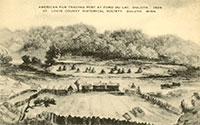Initial interactions between Native people and Euro-Americans in what is now Minnesota began during the 1600s. This contact, and the cultural exchange that followed, were driven by the economy of the fur trade. The French were the first to explore the region and set up a network of forts and fur trade posts. In exchange for furs, Native people received guns, knives, liquor, cloth and other goods manufactured from glass, porcelain, and iron which replaced traditional stone tools and pottery. Over the next century, the Ojibwe and French established relationships with one another. The French embraced Ojibwe culture, learned the language, and married into Ojibwe families. In turn, the Ojibwe sided with the French against the British in wars fought between 1689 and 1763. However, at the end of the French and Indian War, the 1763 Treaty of Paris transferred the area east of the Mississippi River and its headwaters to the British. Through the North West Company, the British sought to gain control of the fur trade in the region west of Lake Superior. Just twenty years later, at the end of the American Revolutionary War, the 1783 Treaty of Paris led to United States control of northeast Minnesota, with the remainder of much of Minnesota being transferred to the United States by the Louisiana Purchase of 1803.
The earliest referenced fur post in the general area of Duluth was recorded by Jean-Baptiste Perrault in 1784. During his travels of that year, Perrault describes visiting the wintering house of British North West Company trader Dufaut on a point within the “Petit Lac” (St. Louis Bay). In 1793, the North West Company chose to construct a permanent post at the mouth of the St. Louis River. Fort St. Louis, as it was called, was located in present-day Superior, Wisconsin. This location was strategic as control of the St. Louis River, meant control of the inland Savannah Portage that lead to the Mississippi River and points beyond. Even after the 1783 Treaty of Paris placed the Fond du Lac region under the control of the United States, the British North West Company continued to control the region’s fur trade. Only after 1809 did John Jacob Astor’s American Fur Company seek to make inroads into the trade even forming a joint enterprise with the North West Company in 1811 known as the South West Company. However, the onset of the War of 1812 the following year led to the merger quickly being dissolved and the North West Company once again controlled the Fond du Lac trade. However, after the war, the American Fur Company took control of the region and Fort St. Louis was last occupied in 1817.
After the War of 1812, the American Fur Company constructed a post at present-day Fond du Lac near the east end of the Grand Portage of the St. Louis River. Maps and paintings illustrate the location of the post on the north side of the river adjacent to an Ojibwe village. In 1832, about 150 people lived at the village including people from Sandy Lake as well as the family of voyageurs. The post at Fond du Lac closed in 1842 in the face of financial downturns and a lack of demand for pelts as silk hats became more popular than felted beaver hats in European fashion. In 1834 a mission school under the oversight of the American Board of Foreign Missions was also established at Fond du Lac. The mission continued at the location through at least 1849. After the closure of the American Fur Company’s post, individual traders licensed by the government continued to work in the area through about 1870.
At the dawn of the nineteenth century, further dramatic changes took place in Native American and Euro-American ways of life in the region that would become Minnesota. The year 1837 marked the beginning of a series of land cession treaties with the Dakota and Ojibwe. Through the treaties of this year, territory east of the Mississippi River and below the mouth of the Crow Wing River became available for white settlement. Additional treaties with the Ojibwe followed, including the 1854 Treaty with the Chippewa (Treaty of La Pointe) of the Lake Superior bands that ceded the lands of the Arrowhead Region to the United States. However, the Ojibwe retained the rights to hunt, fish, and gather within the treaty boundaries. The following year, the 1855 Treaty with the Chippewa (Ceded Territory Treaty) of the Mississippi, Pillager, and Lake Winnibigoshish bands resulted in the cessation of much of the remaining lands of northern Minnesota to the United States and the creation of nine reservations. Throughout the treaty period, Ojibwe families continued to pursue their traditional way of life both within their reservations and in the ceded lands surrounding them. At first Euro-American encroachment into the lands ceded by the Ojibwe progressed slowly in comparison to southern Minnesota where navigable waterways and expansive agricultural lands spurred settlement. However, in the second half of the nineteenth century, the growth of the lumber industry, the expansion of railways, and the discovery of iron ore would spur the exponential growth of the port city of Duluth.
Associated Images
click for larger image with caption
Copyright © 2022. All rights reserved.



